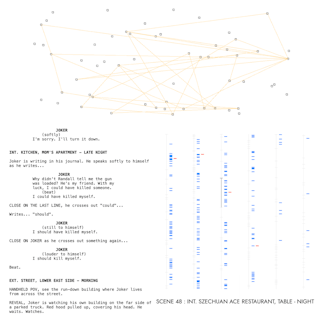
This work of experimentation delves into film scripts and lays the foundation for future works in cinema semantic analysis.
Faced with the richness and density of information in these works, can machines provide a relevant alternative perspective for exploration?
The Movie Script Analyzer project began as an exploration and continued as a series of experiments without a specific destination in mind. The initial goal was to uncover what could be revealed through automated analysis of film scripts.
Film scripts are a treasure trove of information, encompassing not only dialogues but also a comprehensive list of characters, settings, moments, and meticulous stage directions that intricately describe character actions.
After using machine learning algorithms to structure and extract raw data, I focused on their representation. Characters, settings, timelines, actions – this attempt at an interface leverages the exhaustive analysis provided by the machine to offer a different way of exploring a film.

Seeing the diversity of this data, I was consumed by the compelling idea of combining and shaping it interactively – of being able to observe a film omnisciently.
The notion of creating an interface summarizing all character actions in time and space, along with the various connections between them, fascinated me. Imagine a sort of omniscient trace of the film, where everything is accessible at a glance.

This ambition brought to mind the work of Christopher Hooton, who calculated the average color of each film frame to create a colorful timeline representing its visual aesthetics.
Soon, a fundamental question arose: How can these event sequences be visually represented? After all, they can unfold both in space and time.
What I particularly appreciate about this interface is its ability to extend the film experience. By using it, we can immerse ourselves in the work's universe, track the protagonists' movements, and explore underlying themes and motifs.
POTENTIAL APPLICATIONS
Based on these experiments, various potential applications can be envisioned in different domains such as:
Film Industry
An invaluable resource for directors and screenwriters, enabling visualization of narrative structure, identification of inconsistencies, and exploration of new ideas.
Education
An educational platform for teachers and students of film, simplifying the study of narrative construction and direction.
Research
A tool for media and culture researchers, opening pathways for quantitative and qualitative studies on themes, patterns, and representation in films.
DESCRIPTION OF THE INTERFACE
The point cloud at the top of the interface represents the different locations in the movie (currently placed randomly). Hovering over the timeline with the cursor updates the cloud by connecting the locations based on the characters' movements. Below, there's a 3D representation of the action matrix: actions on the x-axis and characters on the y-axis. Here, you can clearly see the quantity of actions detected on the Joker's axis. The selected pair is displayed in yellow.
A 2D representation of the action matrix allows you to navigate with the mouse on the 3D representation and select a character-action pair (here: JOKER-laughing). A cursor allows you to change the perspective of the 3D matrix.
On the right, the elements that make up the selected pair are represented temporally on the movie's timeline (the same timeline as my project "Narrative Constellations"). In blue: the moments when the selected character appears (here, the JOKER), and in red: the occurrences of the selected action (here, laughing).
Perhaps, deep down, I was simply captivated by the Marauder's Map that the Weasley brothers offer to Harry Potter...